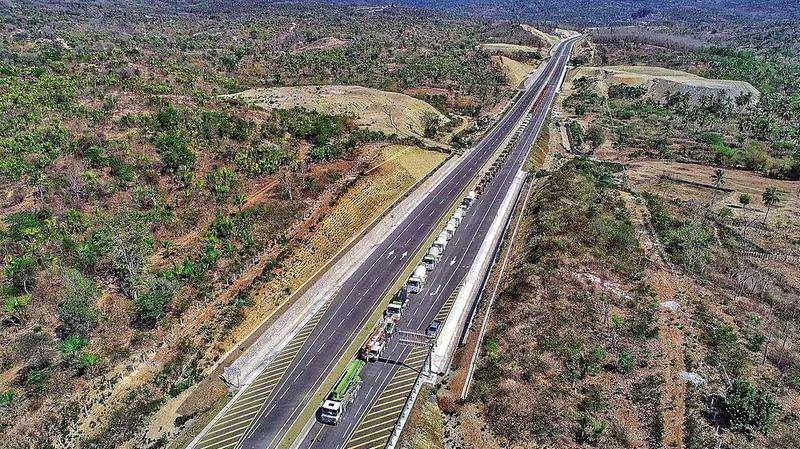BEIJING, Aug. 22 (Xinhua) -- The Suai Highway project is an important transport link for Timor-Leste's oil city under plan in the south, which is of great significance for the future development of the country. It is a path leading to prosperity and modernization, said H.E. Mr. Taur Matan Ruak, prime minister of the Democratic Republic of Timor-Leste (Timor-Leste).
The Suai Highway will become a path to get rich, and people here are all looking forward to its completion, said a driver in Timor-Leste.
This praise-winning highway, undertaken by a joint venture (JV) between China Overseas Engineering Group Co., Ltd. (COVEC) and China Railway First Group Co., Ltd. (CRFG), is situated on Timor-Leste's southern coast and is country's first highway.
Historic changes for economic development
Located at the easternmost tip of the Nusa Tenggara islands in Southeast Asia, Timor-Leste is one of the least developed countries in the world where infrastructure lags behind and transportation is inconvenient.
Except for capital Dili, bumpy unsurfaced roads are seen everywhere in the country and it would take a long time to go anywhere, said the local driver.
Officially started in January 2016, the Suai Highway project, a 155.7-kilometer (km) two-way four-lane highway is projected of a speed of 100 km/h. The project had its 30.4 km-long first phase completed last November.
People here believe that economic development here will see historic changes upon completion of Suai Highway, the local driver said.
Foreign companies in Timor-Leste have long been the ones from Australia, Indonesia, Portugal, etc. Lin Mingming, general manager of the COVEC-CRFG JV said, "At first, the local government did not trust us. After many in-depth studies and field visits, they came to realize that the standards and technologies that Chinese companies apply are in many ways better than European and American standards, and they finally recognized the strength of Chinese companies."
Full confidence in future life
With the arrival of Chinese constructors and the progressing of the project, villages along the Suai Highway have witnessed great changes. Villagers, who used to live in thatched sheds, have built brick houses, and more motorcycles can be found on the streets, according to the head of a small village along the highway. The construction of the highway has brought opportunities for the economic development of the village. Now the villagers are busy with immense joy. Chinese companies have also built bridges in the village which facilitated our lives, he added.
In addition, the project equiped many local workers with advanced skills, which played key role in promoting Timor-Leste’s sustainable development. The project created more than 2,000 jobs for locals, and local employees accounted for about 80 percent of the total. "Most of the local workers employed for the project are farmers who used to be engaged in simple agricultural production activities with very low incomes. Now, local people not only earn a steady income, but also have grasped skills to drive construction vehicles and operate equipment," said Bu Wei, chief engineer of the third division of the COVEC-CRFG JV. The project has trained a large number of local engineers and mechanical operators, who will soon be able to find jobs in other infrastructure projects.
People hope to build this highway into a high-quality project of cooperation between China and Timor-Leste, so as to take the friendship between the two countries to a higher level, said a local project technician, adding that they are very proud to be part of this historic project and they are very confident about our future life."
More importantly, the construction of the Suai Highway will open a window for local people to the outside world and the future. These changes are not only positive results of mutually beneficial cooperation between the two countries, but also a full manifestation of the friendship between the two, said Xiao Jianguo, Chinese ambassador to Timor-Leste.
More mutually beneficial cooperation to come
Timor-Leste is rich in oil and gas reserves. It has attached great importance to the development of Greater Sunrise gas field, where proven oil reserves are 226 million barrels, with an estimated value of about 14 billion U.S. dollars, and about 145.265 billion cubic meters of natural gas, estimated at about 40 billion U.S. dollars. To benefit directly from the oil and gas industry, Timor-Leste is pushing forward the implementation of the 2011-2030 development strategy plan, with the construction of oil city in the south as a priority.
The development of Timor-Leste has a long way to go. Shored up by infrastructure development, the country can realize its development strategy plan, said Longuinhos dos Santos, minister of the Ministry of Tourism Trade and Industry. The Suai Highway project will provide convenient transportation for the construction of oil city in the south and become an important driving force for the local economic development, thus promoting the economic development of the south and even the whole country.
The Suai Highway is an important project witnessing the friendly cooperation between Timor-Leste and China, José Agostinho da Silva, Minister of Transport and Communications, said.
José Manuel Ramos-Horta, former president of Timor-Leste, pointed out that the Belt and Road Initiative has enhanced global infrastructure connectivity and trade development. Timor-Leste is willing to work with China to push for new achievements under the framework of the Belt and Road. (Edited by Niu Huizhe, niuhuizhe@xinhua.org)




 A single purchase
A single purchase









